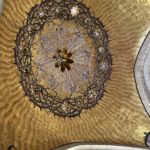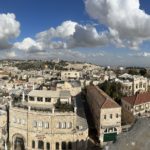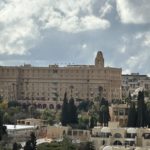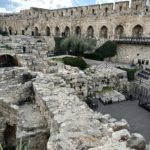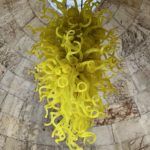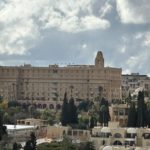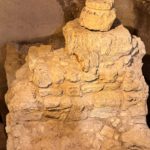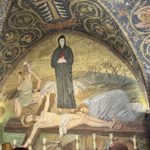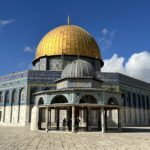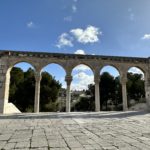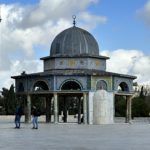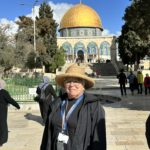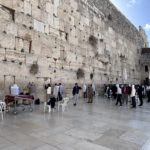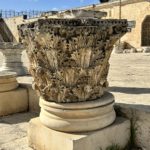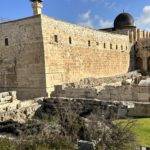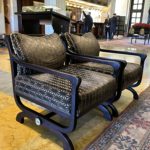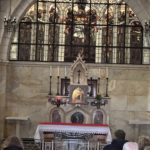
Mbanga Men gathering at the Western Wall. The smaller stones sat the top are later additions, the oldest are lower, huge blocks.
Seroquel online no prescription We began our day by entering the gate in the wall closest to the Western Wall. After passing through security, Michal gave us instructions about how to proceed. This particular area is under the control of the Orthodox Jews. We had written notes/prayers on slips of paper, folded them into tiny squares. Women went to the right, separated from men by a wall. We each approached the wall, placed our hands on the wall, said a little prayer, and inserted our prayer note in a crack in the wall. Next door in the men’s section the same thing was going on. Since it was Monday, 13 year old boys and their families were coming to celebrate their bar mitzvah and read for the first time from the torah – with the women on one side of the wall and the men on the other. The women, dressed to the nines, for this special occasion stood on benches to peer over the fence.
Next we proceeded to Temple Mount, venerated as a holy site for thousands of years by Jews, Christians, and Muslims alike to go through security again. Gazed on the magnificent golden Dome of the Rock under which, according to Jewish tradition, lies the foundation stone of the world, and where Abraham almost sacrificed his son Isaac. The Dome of the Rock was built in AD 688-91 and was one of the first and viewed as the greatest achievements of Islamic architecture. It was intended to proclaim the superiority of Islam and provide an Islamic focal point in the Holy City. The dome was originally copper but is now covered with gold leaf thanks to the support of the late King Hussein of Jordan to get on the good side of Muslims world-wide. It took 176 pounds of 24-carat gold to re-gild the dome in 1993. Since we were not Muslim, we were not permitted to enter either building. The Dome of the Rock is supposedly the spot where Mohammed rose into heaven. Michal referred to the Temple Mount as the belly button of religion. We did walk all around the Dome of the Rock and we spent some time in front of El-Aqsa Mosque learning more about the Muslim faith. One interesting note was that Muslim women pray at the Dome of the Rock, while Muslim men pray at the El-Aqsa Mosque.
We strolled by the entrance to the Cotton Market to leave by a northern gate to reach the Old City, we followed the Via Dolorosa (which traditionally traces the last steps of Jesus from where He was tried to Calvary where He was crucified) west to the Church of the Holy Sepulchre on Calvary, where we saw the two holiest sites in Christianity: the site of Jesus’ crucifixion and the empty tomb from where He is said to have resurrected. Our trail started at the Monastery of the Flagellation which is under the control of Franciscans and climbed up on steep streets to Calvary. The Via Dolorosa’s path has changed over the years but many pilgrims walk the route, pausing at the Stations of the Cross. On Fridays, the Franciscans lead a procession along the route. The 14th Station is the Holy Sepulchre itself. The first basilica of the Church of the Holy Sepulchre was built by Roman emperor Constantine between AD 326 and 335 at the urging of his mother St Helena. It was destroyed by Fatimid sultan Hakim in 1009, rebuilt in the 1040s, enlarged by crusaders in 12th century, and damaged during a fire in 1808 and an earthquake in 1927, requiring extensive repairs. At the heart of the church, a marble shrine known as the Aedicule encloses the place where Jesus’ body was laid to rest after his death. The Stone of Unction commemorates the anointing and wrapping of Jesus’ body. We saw many people placing gifts on the stone to receive a blessing of the gifts they want to give to others, thereby transferring the blessing to gift recepient. This church is under control of Greek Orthodox, Catholics, Armenians, Copts, Ethiopians and Syrians. They have physically taken control of specific areas and we saw various sects taking part in various customs and focus. The church actually houses the 10th to 14th Stations of the cross: Golgotha/Calvary where Jesus is stripped of His garments, Jesus is nailed to the Cross, Jesus dies on the Cross, Jesus taken down from Cross, and Jesus is laid in the tomb.
After a traditional falafel lunch, we continued on, exploring the Christian Quarter, the Arabic Quarter, and the Armenian Quarter. Each of the quarters had several Roman ruins.
Off we go to visit the Tower of David, also known as Jerusalem’s Citadel. The archaeological ruins date back 2,700 years. The museum uses multimedia (maps, holograms, and models) to present 4,000 years of Jerusalem’s history. A walk around the ramparts offered spectacular views of the city. There is a lot to see here, and they have designated three routes: observation route runs along ramparts and has best views of Jerusalem; the excavation route concentrates on the archaeological remains in the courtyard; the exhibition route takes in the displays and dioramas tracing the city’s history.
The travel group in Jerusalem.


